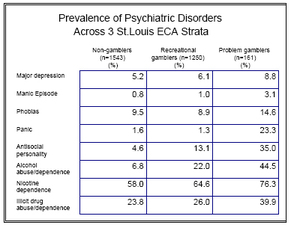In 1978, The President’s Council on Mental Health (PCMH) released a report identifying the limitations of existing psychiatric epidemiological research and the need for new studies. The PCMH hoped that by using the most up-to-date diagnostic methodologies, the new research would produce accurate prevalence rates for a wide range of mental disorders as well as a meaningful evaluation of the need for and use of clinical services. Addressing the concerns of the report, NIMH awarded grants to five sites for the implementation of new, comprehensive epidemiological studies. The respective studies of the five recipients (Yale, Johns Hopkins, Washington University, Duke, and UCLA) make up the Epidemiological Catchment Area study (ECA). The ECA is distinguished by many features, the most salient of which is sample selection. Rather than limiting the sample to particular subgroups (e.g., institutionalized patients), the ECA samples represented all the respondents who would normally reside in a particular geographic area. Investigators used the DSM-III based Diagnostic Interview Schedule (DIS) as their primary instrument [1].
The Washington University study in St. Louis was the only ECA component study to investigate the prevalence of pathological gambling. It should be noted that the diagnostic criteria used by the DIS to identify pathological gamblers are not identical to those used by the DSM-III. According to the DIS, gamblers must have gambled at least twice in their lives, thought they gambled too much, and have experienced two or more of the following conditions as a result of their behavior: 1) inability to pay bills 2) trouble at home or work 3) borrowing or stealing money. Using this model and a sample of 3,004 adults, researchers found the lifetime prevalence rate of pathological gambling among the St. Louis population to be 0.9%. Equally interesting, however, are the findings concerning comorbidity. A direct relationship was found to exist between the severity of a respondent’s disordered gambling and the probability of diagnosis for psychiatric disorders. Respondents were stratified into non-gamblers, recreational gamblers, and problem gamblers. The latter includes respondents who reported at least one gambling-related problem in addition to those diagnosed by the DIS/DSM-III as being pathological gamblers [2]. The results are presented in the table. It should be noted that the percentages listed have been adjusted using weights for age, sex, and race.
Sources:
- Regier, D.A. et al. (1984) The NIMH Epidemiologic Catchment Area Program: Historical context, major objectives, and study population characteristics. Archives of General Psychiatry. 41,934-941.
- Cunningham-Williams, R.M. et al. (1998). Taking chances: Problem gamblers and mental health disorders- results from the St. Louis Epidemiologic Catchment Area Study. American Journal of Public Health, 88(7), 1093-1096.
This public education project is funded, in part, by The Andrews Foundation and the National Center for Responsible
Gaming.
This fax may be copied without permission. Please cite The WAGER as the source.
For more information contact the Massachusetts Council on Compulsive Gambling, 190 High Street, Suite 6, Boston, MA 02110, U.S.





